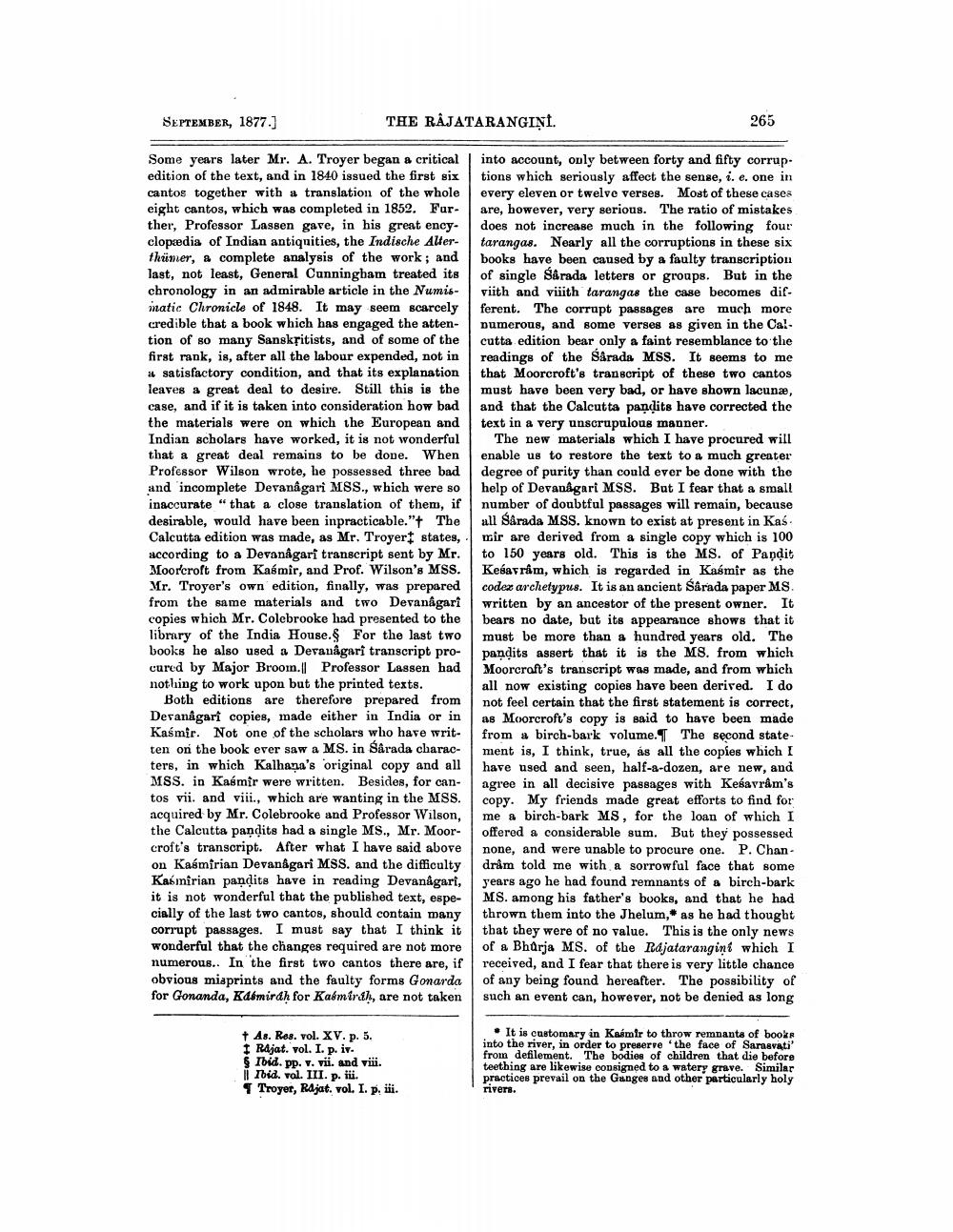________________
SEPTEMBER, 1877.]
THE RAJATARANGIŅI.
265
Some years later Mr. A. Troyer began a critical into account, only between forty and fifty corrupedition of the text, and in 1840 issued the first six tions which seriously affect the sense, i. e. one in cantos together with a translation of the whole every eleven or twelve verses. Most of these cases eight cantos, which was completed in 1852. Far- are, however, very serious. The ratio of mistakes ther, Professor Lassen gave, in his great ency. does not increase much in the following four clopaedia of Indian antiquities, the Indische Alter- tarangas. Nearly all the corruptions in these six thümer, a complete analysis of the work; and books have been caused by a faulty transcription last, not least, General Cunningham treated its of single Sarada letters or groups. But in the chronology in an admirable article in the Numis- viith and viiith tarangas the case becomes difinatic Chronicle of 1848. It may seem scarcely ferent. The corrupt passages are much more credible that a book which has engaged the atten- numerous, and some verses as given in the Ca! tion of so many Sansksitists, and of some of the cutta edition bear only a faint resemblance to the first rank, is, after all the labour expended, not in readings of the Sarada MSS. It seems to me #satisfactory condition, and that its explanation that Moorcroft's transcript of these two cantos leaves a great deal to desire. Still this is the must have been very bad, or have shown lacuna, case, and if it is taken into consideration how bad and that the Calcutta pandits have corrected the the materials were on which the European and text in a very unscrupulous manner. Indian scholars have worked, it is not wonderful The new materials which I have procured will that a great deal remains to be done. When enable us to restore the text to a much greater Professor Wilson wrote, he possessed three bad degree of purity than could ever be done with the and incomplete Devanagari MSS., which were so help of Devanagari MSS. But I fear that a small inaccurate " that a close translation of them, if | number of doubtful passages will remain, because desirable, would have been inpracticable."+ The all Sarada MSS. known to exist at present in Kas Calcutta edition was made, as Mr. Troyer states, mir are derived from a single copy which is 100 according to a Devanagari transcript sent by Mr. to 150 years old. This is the MS. of Pandit Moorcroft from Kasmir, and Prof. Wilson's MSS. Keśavram, which is regarded in Kasmir as the Mr. Troyer's own edition, finally, was prepared codex archetypus. It is an ancient Sarada paper MS. from the same materials and two Devanagari written by an ancestor of the present owner. It copies which Mr. Colebrooke had presented to the bears no date, but its appearance shows that it library of the India House. For the last two must be more than a hundred years old. The books he also used a Devanagari transcript pro- pandits assert that it is the MS. from which cured by Major Broom.|Professor Lassen had Moorcraft's transcript was made, and from which nothing to work upon but the printed texts. all now existing copies have been derived. I do
Both editions are therefore prepared from not feel certain that the first statement is correct, Devanagari copies, made either in India or in as Moorcroft's copy is said to have been made Kasmir. Not one of the scholars who have writ- from a birch-bark volume. The second state ten on the book ever saw a MS. in Sarada charac- ment is, I think, true, ás all the copies which I ters, in which Kalhana's original copy and all have used and seen, half-a-dozen, are new, and MSS. in Kasmir were written. Besides, for can- agree in all decisive passages with Kesavr&m's tos vii. and viii., which are wanting in the MSS. copy. My friends made great efforts to find for acquired by Mr. Colebrooke and Professor Wilson, me a birch-bark MS, for the loan of which I the Calcutta pandits had a single MS., Mr. Moor- offered a considerable sum. But they possessed croft's transcript. After what I have said above none, and were unable to procure one. P. Chanon Kasmirian Devanagari MSS. and the difficulty dram told me with a sorrowful face that some Kasmirian pandits have in reading Devanagari, years ago he had found remnants of a birch-bark it is not wonderful that the published text, espe- MS. among his father's books, and that he had cially of the last two cantos, should contain many thrown them into the Jhelum, as he had thought corrupt passages. I must say that I think it that they were of no value. This is the only news wonderful that the changes required are not more of a Bharja MS. of the Rajatarangin which I numerous.. In the first two cantos there are, if received, and I fear that there is very little chance obvious misprints and the faulty forms Gonarda of any being found hereafter. The possibility of for Gonanda, kdemirdh for Kalmirth, are not taken such an event can, however, not be denied as long
† As. Ros. vol. XV. p. 5. I Rajat. vol. I. p. iv.
Ibid. pp. v. vii. and viü. Il Ibid. val. III. p. iii.
Troyer, Rajat. vol. I. p. iii.
• It is customary in Kasmir to throw remnants of books into the river, in order to preserve the face of Sarasvati from defilement. The bodies of children that die before teething are likewise consigned to a watery grave. Similar practices prevail on the Ganges and other particularly holy rivers




